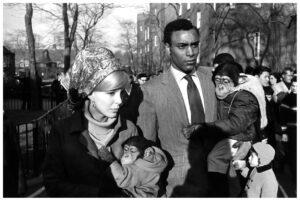Following on from my post on 15th November, here are some edited highlights and my responses on issues raised by Module 3, which looked at image and identity in photography
KB: The Arnold Newman photo of Stravinsky (below) really struck me as a wonderful image. Looking at the couple in the park by Gary Winogrand (below), the initial take was the fact that it is a mixed race couple in the US of the 60s. I think 1967 was the year interracial marriages were legal in the US? I only noticed the chimpanzees on reading the title!
BH: The Winogrand is a striking picture and one that shows the benefit of detailed reading, too often we glance at images and miss the subtleties and nuances. This picture had a recent notorious outing: Danny Baker used it in a tweet about Prince Harry and Meghan Markle, something that I imagine still gives him sleepless nights.
In 1967 the US Supreme Court declared state laws against interracial marriage illegal; it had been legal in some states for a long time.
KB: Somewhere there is a photo of our family with monkeys taken by a beach photographer. Thank goodness that doesn’t happen here now.
BH: I too have one of those monkey photographs. Those days of supposedly innocent fun were not always quite so innocent.
GM: I’ve often thought that calling photography an art is pushing it to say the least unless manipulating the light is an art form. Given that photographers start with a snap, a moment in time, where’s the real creativity? I suppose those that change the image considerably in Photoshop move into the area of graphic designers. Even then it’s not like photographers are painters, composers or authors who produce their work from scratch with a blank canvas or sheet of paper with their own imaginations.
BH: On the question of photography and art we will have to agree to differ. I try to address this in Module 4, but here are a few observations in the meantime.
1. If we think of art as ‘the application of human creative skill and imagination, typically in a visual form, producing works to be appreciated primarily for their beauty or emotional power’, then I would argue that photography is capable of achieving this.
2. We might alternatively look at art is as a form of communication, a way of conveying ideas, of trying to understand the human condition. Photography is hardly deficient in this respect.
3. Painters have total freedom, limited only by their imagination, to create the work of art; photographers must distil the essence that makes up the work of art out of what is in front of them. The latter in not always easier nor less creative than the former. Moreover the finished work of many painters are worked up from sketches often made from life – it’s not just down to imagination.
4. Both painting and photography depend upon a command of knowledge and technique, in effect on craft skills. Both are capable of producing profound art; both are capable of producing bad ‘art’; both might be employed just for decoration. If it’s reduced down to the application of technical skills many famous artists would be found wanting.
GM: To sum up, I’d say that photographers are more technicians than artists, which is in no way to denigrate the former. Who can fail to have been impressed with electron micrographs which call for extraordinary levels of skill in the preparation and execution as do many other areas of photography. I shall look forward to being amazed again at the NHM Wildlife Photographer of the Year soon I hope.
BH: I agree there are technical areas of photography that require great skill, see above. Coincidentally the pictures they produce are often very beautiful, and that’s certainly true of the Wildlife Photographer of the Year pictures, which I’ve enjoyed enormously in previous years. But are they art? Something I raise in Module 4.
MM: The image of Thomas Carlyle (below) suggests a man of focus and intensity that reflects his role as a historian and author. August Sander’s pastry cook (below) looks German and his face could easily fit into a picture of the WW1 trenches or the Prussian court, but because it is an environmental portrait his occupation is made clear.
BH: Does the cook actually look German, or does he look how we think Germans look? Anyway it’s a penetrating picture.
MM: Nudes: I think Bill Brandt was a pioneer of exploring the human body from unusual angles and playing with the sense of scale.
BH: In 1945 Brandt bought a special Kodak camera in a second-hand camera shop in Covent Garden, London. The camera had been designed to enable untrained police staff to photograph crime scenes. It had a very wide-angle lens and gave Brandt the distortions and great depth of field that characterise some of his work. Very beautiful.
MM: Nan Goldin (below): She consistently produces very powerful images that are convincingly real but always have an unsettling quality. I have found some of her pictures of hard drug use particularly disturbing.
BH: Agreed. Her show at Tate Modern a year of so back was hard hitting and one is almost surprised she survived. Is it art? See Module 4.
MM: Migrant/refugee photos (below): An unbearably poignant picture, but I do wonder whether the prints on the beach were artfully rearranged by the photographer?
BH: You are right to ask, but I think it’s a truthful image, see the piece on my blog https://brianhuman.co.uk/wp/the-itinerary/. You may recall similar doubts about the picture of the body of Alan Kurdi, 2, washed up on a Turkish beach Sept. 2, 2015 – it was subsequently accepted as being a truthful record. I’ll cover this in Module 5.






